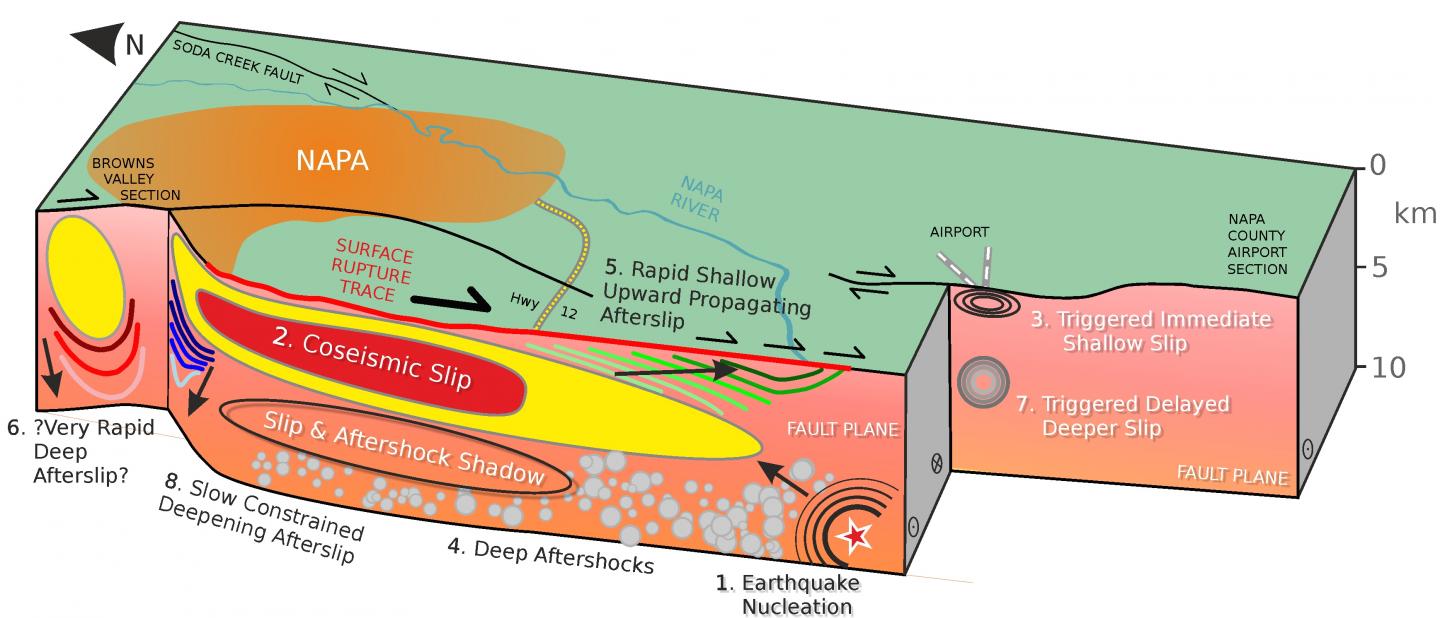
Schematic summary of research findings showing the sequence of slip behavior.. Source: UC Riverside
Preparation and good timing enabled Gareth Funning and a team of researchers to collect a unique data set following the 2014 South Napa earthquake that showed different parts of the fault, sometimes only a few kilometers apart, moved at different speeds and at different times.
Aided by GPS measurements made just weeks before the earthquake and data from a new radar satellite, the team found post-earthquake fault movement, known as afterslip, was concentrated in areas of loosely packed sediment. Areas where the fault passed through bedrock tended to slip more during the actual earthquake.
Sections of Highway 12, which runs through the earthquake zone, were broken during the initial 6.0 magnitude earthquake and were further damaged in the coming days due to afterslip. In some areas the afterslip damage exceeded the initial damage from the earthquake.
“No one has seen variability in afterslip like we saw,” said Funning, an associate professor of earth sciences at the University of California, Riverside. “This helps us address a big question: Can we use geology as a proxy for fault behavior? Our findings suggest there is a relationship between those two things.”
The findings could have significant implications for earthquake hazard models, and also for planning earthquake response. If geological information can give a guide to the likely extent of future earthquakes, better forecasts of earthquake damage will be possible. And if areas likely to experience afterslip can be identified in advance, it can be taken into account when building or repairing infrastructure that crosses those faults
California, in particular the Hayward and Calaveras Faults, which run along the east side of the San Francisco Bay, seems more susceptible to afterslip than other earthquake-prone regions throughout the world, Funning said.
The findings on the South Napa earthquake were recently published in paper, “Spatial variations in fault friction related to lithology from rupture and afterslip of the 2014 South Napa, California, earthquake,” in the journal Geophysical Research Letters.
Funning’s work in the region just north of San Francisco dates back to 2006, when he was a post-doctoral researcher at UC Berkeley and noticed the area wasn’t that well studied, at least compared to the central Bay Area.
He continued the research after he was hired at UC Riverside and received funding from the United States Geological Survey to conduct surveys using GPS sensors in earthquake prone areas throughout Marin, Napa, Sonoma, Mendocino and Lake counties.
He began the most recent survey in July 2014. When the South Napa earthquake struck on Aug. 24, 2014, he and three other researchers were in Upper Lake, CA in Lake County, about 70 miles north of the earthquake’s epicenter, making additional measurements.
The earthquake occurred at 3:20 a.m. By noon, Funning and the other researchers, Michael Floyd (a former post-doctoral researcher with Funning who is now a research scientist at the Massachusetts Institute of Technology), Jerlyn Swiatlowski (a graduate student working with Funning) and Kathryn Materna (a graduate student at UC Berkeley), had deployed additional GPS sensors in the earthquake zone in locations that they had, fortuitously, measured just seven weeks earlier.
In total, there were more than 20 GPS sensors set up by Funning’s team and scientists from the United States Geological Survey. They left the equipment out for four weeks following the earthquake.
They then combined the GPS sensor data with remote sensing data. The South Napa earthquake was the first major earthquake to be imaged by Sentinel-1A, a European radar imaging satellite launched in 2014 that provides higher resolution information than was previously available.




